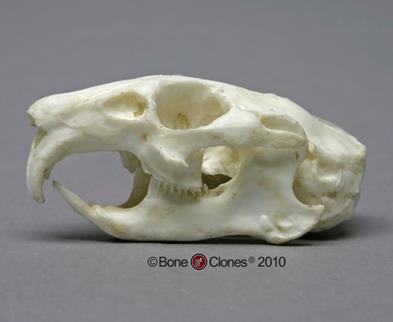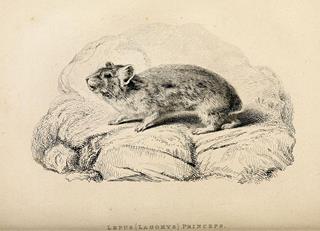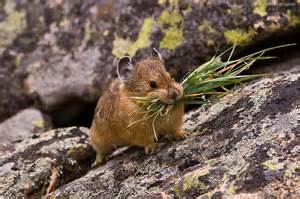Make hay while the sun shines. – unknown
This is a small mammal found at higher elevations in the North America from central British Columbia and south along Rockies, Cascades, and Sierra to California, Utah, and New Mexico. These small critters live in talus fields with adjacent areas of grass and forbs for forage. They look like rodents, but are not. Rodents – such as mice, rats, squirrels and such have four front incisors that continue to grow throughout their life.
In contrast, pika are in the Order Lagomorpha – the same as rabbits and hares, though in a different Family – the Ochotonidae. Lagomorphs have double-ranked incisors. So when you look at a pika skull you see there are a front set of incisors and then a small set of “peg-teeth” right behind these, thought to be of use in grinding grasses and forbs. Thus, they have eight incisors that continually grow.

ikas are small and roundish – think of a fuzzy half-sized nerf football, but one able to scamper amazingly quickly around the rock talus field. They are about 6.5 – 8.5 inches long and only weigh about 6 ounces. Males are slightly large than females. Most of the time you will hear them before you see them as they let out a distinctive “bleat” or “eeeeenk” as a warning to others or just general communication. Here’s what they sound like: https://www.youtube.com/watch?v=W4U9IxhQSTc
Short calls are uttered as alarms and to announce that they are departing or returning from foraging, and males perform a “song” during the breeding season. Males and females maintain individual, same-size territories, usually living next to an individual of the opposite sex. One of my friends insists that they have an ultra-sonic language that we cannot hear and that the loud “bleat” translates to “over” in radio-speak to allow the other pika to carry on the conversation. Whatever.
It was first described by John Richardson in 1882 in the Fauna Boreali-Americana. Richardson was a Scottish naval surgeon, naturalist, and arctic explorer who, with John Franklin, mapped and explored 1,878 miles of coast while looking for the Northwest Passage. Ochotona – Mongolonia for pika; princeps – Latin for chief or prince, reference to Native American word that translates to “little chief hare”.

The name pika comes from the Siberian Tungus language meaning for the sound made by the pika. There are about 30 species/subspecies of pika around the world. The pika is supposedly also known as the rock rabbit, hay-maker, mouse-hare, whistling hare, and cony – but I’ve never heard any of these names.
Pikas have cheek sent-glands that they rub on the rocks to mark their territory. Males and females have separate territories that are about the same size and they usually live adjacent to an individual of the opposite sex. They seem to spend most of their time hanging around, sitting still, and observing their surroundings. Females breed when they are a year old, and have a litter of three after a 30-day gestation period. The young are independent about a month after birth. Predators include coyotes, long-tailed weasels, and martens. An average life span is about 3 years but they have been known to live up to 7 years.
We often think of them as subalpine creatures but in the northern part of the range they can be found at lower elevations – such as in talus along the road in the Columbia Gorge. But they never made it across the Puget Sound lowlands to invade the Olympics. Pika are herbivores and gather plants and pile them for drying – called haying – and store them for the long winter as they do not hibernate. There can be up to 30 plant species in one hay pile.
In the winter they also may feed upon cushion plants and lichens in the area between the snow and the ground. They get most of their water from plant material so don’t have to drink much from surface sources. And as rabbits and hares do, they drop two types of pellets – soft and hard ones. Because they can only digest about 65% of the plant material they eat on the first go-around, they will eat these soft pellets to absorb the now partially digested nutrients.

Several groups petitioned the U.S. Fish and Wildlife Service (USFWS) back in 2009 to list the pika as a threatened species because of global climate change. World temperatures are rising and affecting pika forage plants. In addition, pika needs winter snow pack as insulation from the cold. As snow levels rise and dwindles at the lower elevations, the range of pika habitat is reduced. USFWS declined to list the species as threatened at this time.
On the second of three tries to complete the Ptarmigan Traverse, an 8-day high traverse of the Cascades, we were drying out our soggy items in a weather break on a small tent platform next to the Cache Glacier before tromping back to the car. Steve – all 6’ 4” of him was organizing stuff in his tent as were drinking our tea and he suddenly let out a screech to rival any 6th-grader and bolted from his tent. We stood with raised eyebrows as he stumbled out of the tent almost ripping it from its moorings. “A pika!” He explained – “It ran into the tent, I screamed, and it ran out”. Just remembering it cracks me up – big Steve startled by a little pika who in turn got quite the start from him.
